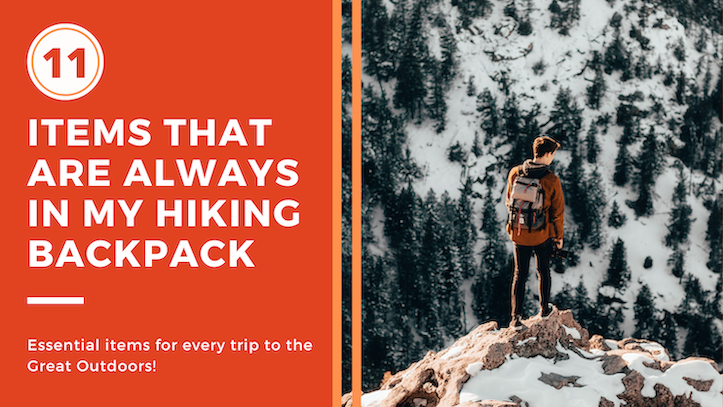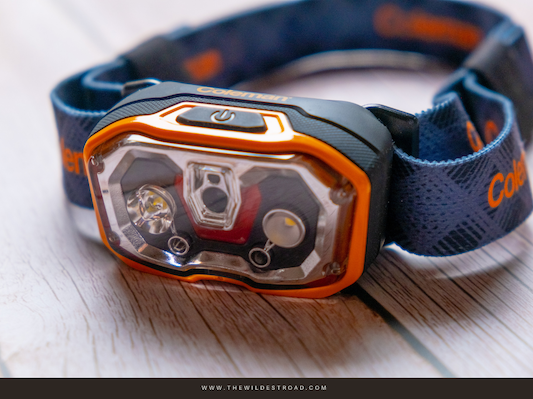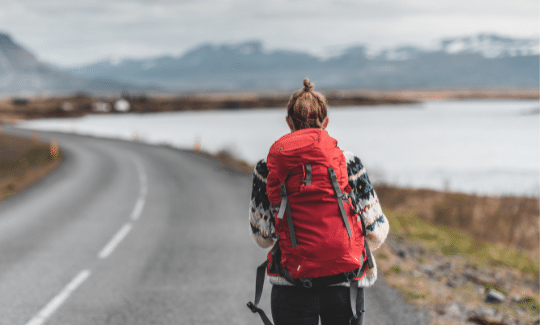11 Items That Are Always In My Hiking Backpack
Whenever Ana and I are hiking or camping, there are always a few favourite items that come with us, no matter the destination. So let’s take a look at our must-have gear!
I hope you’ll enjoy this list, and don’t forget to drop a comment and let us know what your essential items are when out on the trail!
So here they are, the 11 items that are always in my backpack when exploring the Great Outdoors!
#1 - Water Bottle: Klean Kanteen Insulated Classic 592 ml
This is my bottle of choice both out in the wild and in the city.
It’s built like a tank and keeps drinks both hot and cold for a long time.
Despite being full of dents from having been dropped more times than I can remember, it still performs like if brand new.
The only drawback is its weight and relatively small capacity. I find that if there is regular access to water sources I don’t have any issues, but consider pairing with a water bladder if fresh water is scarce.
#2 - Water Filter: Katadyne BeFree 1.0 L Water Filter
This water filter is fast and easy to use, and claims to remove 99.9%.
It filters up to two liters per minute, and you can filter the water into a bottle or drink straight from it.
Cleaning is also a breeze, just shaking the filter with water will do the trick. It also is made of silicone and packs extremely light and small.
The only disadvantage is that it removes microorganisms but not harmful chemicals, so be careful and monitor the local levels of water pollutions before travelling!
#3 - Ferro Rod Fire Starter: Light My Fire FireSteel
A good ferro rod is something that cannot miss in any camper’s pack.
This fire starter is compact, light and waterproof, with a lifespan of about 3000 strikes. For some people that means a one in a lifetime purchase. If you need something bigger, you can also upgrade to the army version that has a lifespan of about 12.000 strikes.
#4 - Outdoor Knife: Benchmade Saddle Mountain Skinner / Fallkniven A1
No matter the length of the trip or the destination, I always carry a knife with me. Which one depends on what it will be used for.
The one that is usually with me is the Benchmade Saddle Mountain Skinner, a light and extremely durable hunting knife that works perfectly for all camp tasks, from preparing dinner to feathering sticks and making tent pegs.
If the trip is more demanding I prefer to carry a Fallkniven A1. This survival knife is close to indestructible, and is suited for all heavy duty camp work, like batoning and chopping branches.
Its size and weight are the only reason I don’t carry it regularly. It measures 16 cm in length and weighs 300 g, meaning that it will add some considerable weight to your backpack and definitely won’t go unnoticed when on your belt!
#5 - Portable Sharpener: Lansky BladeMedic Knife Sharpener
While you should normally have your knife sharpened and ready before you leave, you may sometimes find yourself with a dull blade.
You can’t really afford to carry around a bunch of sharpening stones when out in the field, so a portable sharpener is the logical answer.
I’ve been using the Lansky BladeMedic for close to 5 years now, and it has performed without flaw throughout. It comes with a carbine sharpener for extremely dull blades, a ceramic rod for touch ups, a serrations sharpener and a diamond tapered rod for fast sharpening.
#6 - Compass: Silva Ranger 2.0 / G-Shock Mudmaster
Depending on the activities you prefer, a compass is a tool you might never need but that will make all the difference when you do.
The Silva Ranger 2.0 comes with all the essentials you need for basic navigation, such as a declination scale inside the bezel and map-measuring ruler in millimetres, and scales of 1:50,000 and 1:25,000.
I also use a G-Shock Mudmaster, an outdoor watch made to have the living hell beaten out of it, and that also has a built in compass. The compass on the G-Shock is of course not as accurate as the Silva 2.0, but is always useful as a backup.
You might also like our article: A Hiker’s Guide On How to Use a Compass!
#7 - Paracord: Paracord Planet
A few meters of paracord can be incredibly useful when on the trail.
You can carry it loose or tie it up in a bracelet, either way it doesn’t take much space.
It’s a very strong and lightweight material that can be used to fix broken gear and easily replace tent ropes and shoe laces.
It can even be used to make hunting traps in extreme survival situations or slings and tourniquets if you injure your limbs!
#8 - First-Aid Kit: First Aid Only
A first aid kit needs to be in your pack, no discussions.
Wild camping and trekking is inherently dangerous, so make sure you are able to at least treat small injuries and bruises. Remember that out in the wild even a small cut can quickly get infected and cause serious problems, so make sure to pack disinfectants, bandaids and bandages!
Also keep in mind that you’ll be heavily changing your diet on the trail, so some medicine like Imodium can be very helpful, just in case your stomach doesn’t agree with your life decisions.
You can buy a pre filled first aid kit and add what you need or make your own, just make sure to have the essentials.
#9 - Headlamp: Coleman Divide 175L LED
A good headlamp is a lifesaver if you get caught by nightfall without having set up camp or even if nature calls in the middle of the night.
The Coleman Divide 175L LED is a cheap, battery powered model, and it provides enough visibility for most night-time camp activities.
If you’re counting on using it for night-time trekking however, I would upgrade to something more powerful.
#10 - Waterproof Plastic Pouch: Loksak Drybags
Dry-bags are super useful to protect important documents like a passport from getting wet.
The bag is even touchscreen friendly, meaning you can keep your phone safe and dry while still being able to use it!
#11 - Dry Bags: Osprey Drysack 3 L
Waterproof bags come in handy when it’s rainy and you don’t want any water sensitive gear getting humid and wet.
They’re also useful if you’re crossing a body of water and just happen to drop something or fall in yourself.
The Osprey Drysacks are waterproof, light, compact and have a ripstop mesh for extra durability. I use them primarily to protect electronic equipment or to keep tinder dry.
And there you have it, these are the 11 items that are always with me.
Also, don’t forget to get yourself a copy of our free PDF checklist, it’s a full list of all the gear you might need for all your travels!
See you on the trail and until then, this is Luca, signing off.
Other articles you might enjoy:
𝘿𝙞𝙙 𝙮𝙤𝙪 𝙚𝙣𝙟𝙤𝙮 𝙩𝙝𝙞𝙨 𝙖𝙧𝙩𝙞𝙘𝙡𝙚 ?
𝘠𝘰𝘶 𝘤𝘢𝘯 𝘴𝘢𝘷𝘦 𝘰𝘳 𝘱𝘪𝘯 𝘵𝘩𝘪𝘴 𝘪𝘮𝘢𝘨𝘦 𝘴𝘰 𝘵𝘩𝘢𝘵 𝘺𝘰𝘶 𝘤𝘢𝘯 𝘢𝘭𝘸𝘢𝘺𝘴 𝘭𝘰𝘰𝘬 𝘣𝘢𝘤𝘬 𝘰𝘯 𝘵𝘩𝘦𝘴𝘦 𝘵𝘪𝘱𝘴 !



















